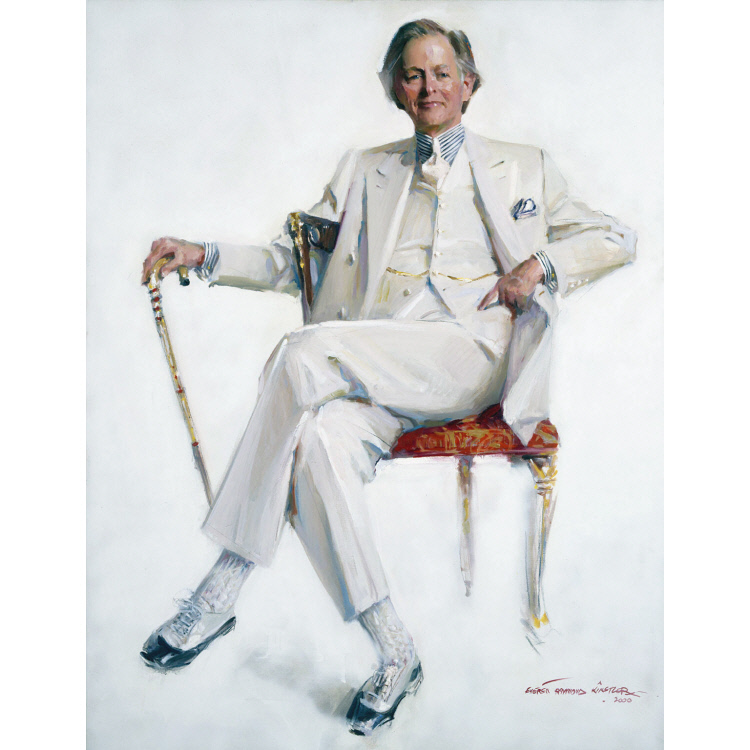
©2002 Everett Raymond Kinstler Source
By now you’ve all seen, heard, and read that the great Tom Wolfe died this week. His social satire and sardonic wit carved out a distinctive path through post-modern America. Wolfe championed a literary style that was part journalism, part acerbic effervescence. Few (if any) recent writers were better able to craft stories by such vivid portrayals of particular people in particular places at particular times.
Here is Tom Wolfe in one of his many interviews with William F. Buckley on Firing Line. Just two mid-century Yale Men parlaying over the Black Panthers, Bernstein, Balzac, Homo Ludens, and the Mets disappointing season.
The question by the gentleman at around 39:45 is actually a good one and a complaint Wolfe faced his entire career. As a chronicler, he had a tendency to paint the events into flourishes that steered the situations toward the underlying themes that he was using to make his broader point. Conversely, as a novelist he was accused of conflating ordinary details into fantastic baroque ideals.
There’s no denying that Wolfe was the master of expansive simplification. The principles of his style required a complete accounting of all the dimensions of the scene.
The culmination of that manifesto was nowhere more on display than in his masterpiece The Bonfire of the Vanities. Here is snippet from chapter 5 following Kramer walking into the DA’s office.
The guard buzzed Kramer through the gate, and Kramer’s running shoes
squeaked on the marble floor. The guard gave them a dubious onceover. As
usual, Kramer was carrying his leather shoes in an A&P shopping bag.
Beyond the entryway, the level of grandeur in the District Attorney’s
Office went up and down. The office of Weiss himself was bigger and showier,
thanks to its paneled walls, than the Mayor of New York’s. The bureau chiefs,
for Homicide, Investigations, Major Offenses, Supreme Court, Criminal Court,
and Appeals, had their share of the paneling and the leather or school-of
leather couches and the Contract Sheraton armchairs. But by the time you got
down to an assistant district attorney, like Larry Kramer, you were looking at
Good Enough for Government Work when it came to interior decoration.
The two assistant district attorneys who shared the office with him, Ray
Andriutti and Jimmy Caughey, were sitting sprawled back in the swivel chairs.
There was just enough floor space in the room for three metal desks, three
swivel chairs, four filing cabinets, an old coat stand with six savage hooks
sticking out from it, and a table bearing a Mr. Coffee machine and a
promiscuous heap of plastic cups and spoons and a gummy collage of paper
napkins and white sugar envelopes and pink saccharine envelopes stuck to a
maroon plastic tray with a high sweet-smelling paste composed of spilled coffee
and Cremora powder. Both Andriutti and Caughey were sitting with their legs
crossed in the same fashion. The left ankle was resting on top of the right
knee, as if they were such studs, they couldn’t have crossed their legs any
farther if they had wanted to. This was the accepted sitting posture of
Homicide, the most manly of the six bureaus of the District Attorney’s Office.
Both had their jackets off and hung with the perfect give-a-shit
carelessness on the coatrack. Their shirt collars were unbuttoned, and their
necktie knots were pulled down an inch or so. Andriutti was rubbing the back
of his left arm with his right hand, as if it itched. In fact, he was feeling
and admiring his triceps, which he pumped up at least three times a week by
doing sets of French curls with dumbbells at the New York Athletic Club.
Andriutti could afford to work out at the Athletic Club, instead of on a carpet
between a Dracaena fragrans tub and a convertible couch, because he
didn’t have a wife and a child to support in an $888-a-month ant colony in the
West Seventies. He didn’t have to worry about his triceps and his deltoids and
his lats deflating. Andriutti liked the fact that when he reached around behind
one of his mighty arms with the other hand, it made the widest muscles of his
back, the lats, the latissima dorsae, fan out until they practically split his
shirt, and his pectorals hardened into a couple of mountains of pure muscle.
Kramer and Andriutti were of the new generation, in which the terms triceps,
deltoids, latissima dorsae, and pectoralis major were better known than the
names of the major planets. Andriutti rubbed his triceps a hundred and twenty
times a day, on the average.
And that’s just the scene and status. The dialogue continues with the obligatory obscenities and a glimpse of “donkey loyalty”, as Wolfe calls the tribal ties that contrast the “Favor Bank” of the legal system.
Rest in Peace Tom Wolfe, and thank you for your works that contributed to our awareness and understanding of this ever perplexing world.